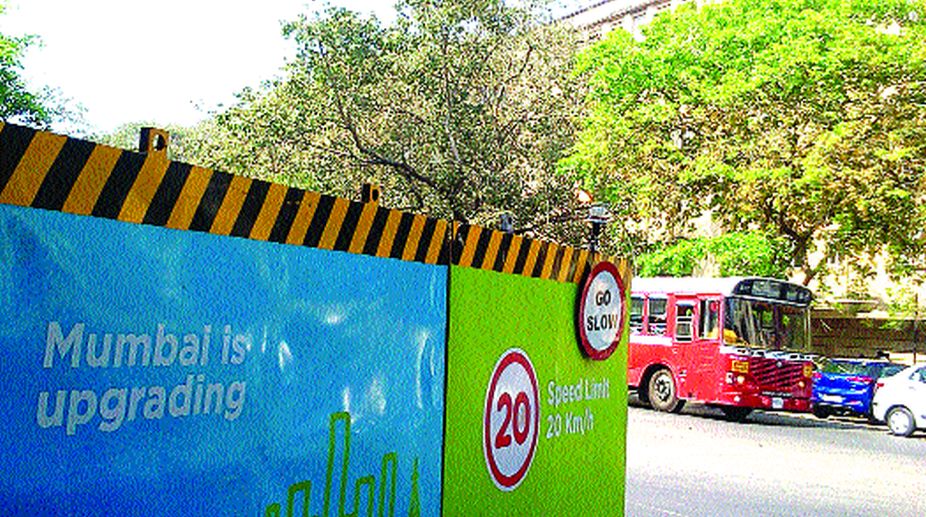Mumbai is upgrading’ declare blue, green road boards around Churchgate, with work starting on the Colaba-Bandra-SEEPZ Mumbai Metro rail corridor – for commuting to be less daily torture for millions.
When wisely used, ‘upgrading’ becomes a word bubbling with progress, quality, evolution, a better life. Without wiser civilization upgrades, we might still be in caves using Stone Age accessories.
Mumbai upgrading in any way sounds gratifying, for I owe a great debt to this special city that is my home since 1991. Here in 1993, when I was writing on street children, a social worker mentioned to me this word ‘Vipassana’. My fledgling journalism career was taking off, and I was not particularly looking for any path or process to upgrade my life. Yet I promptly went to the Dhamma Thali Vipassana Center in Jaipur – a young Raja in Rajasthan, amid Dhamma Thali’s dancing peacocks, the king of birds, and monkeys in trees– fitting reminders of this monkey-mind jumping from past to future, rarely still in reality of the present moment, this mind full of tricks.
Most fortunately, in some protection of destiny, I did not think of writing an article on Vipassana before or during my first 10-day course. It enabled experiencing the depths, instead of superficial analysis with the surface-level intellectual part of the mind. Judging Vipassana through mere words is like measuring the Indian Ocean with a teacup.
Instead, those days in Dhamma Thali became an inner revolution, an explosion of deep-rooted realizations beyond vocabularies, a subliminal connection to my real work in life. Later I did write about my experience for The Statesman, and then sub-editor Indrani Bagchi said the article got a phenomenal response. Not surprising, because this is time for the Vipassana inner revolution to upgrade lives across India and the world. “Time-clock of Vipassana has struck”, often said Sayagyi U Ba Khin (1899 – 1971), independent Burma’s first Account General who greatly wished that Vipassana return to India, the country of its origin.
Vipassana (www.dhamma.org) or ‘insight’ in ancient Pali language means to ‘see reality as it is’. This faculty of gaining insight impacts life like a person gaining sight after being blind from birth.
Reality changes from moment to moment. I experience the cup of life brimming with quiet happiness, but I know this too shall pass…. and maybe when the dark clouds return, dangerous storms burst again through disturbed days, I know, yes, that too will change.
For change is the only constant, through the great Law of Cause and Effect. We reap the fruits of life from seeds of volition we sow each moment. Understanding the continuity of cause and effect is heart of the mind revolution called Vipassana. We understand, through direct experience, subtler realities of this mind-matter phenomenon called ‘I ’, the upgrading in life – and to share all benefits thereby gained, in an undying circle of infinite gratitude.
This feeling of gratitude empowers life’s upgrades, to share all benefits gained. Generous Mumbai has the world’s largest number of Vipassana practitioners, fellow explorers of experiential wisdom – no blind faith and imprisoning dogma. Mumbai was also home to the late Principal Vipassana Teacher Sayagyi U Goenka (1924 – 2013) – infinite gratitude to this Most Compassionate Being, for his ultimate sacrifice enabled gaining this self-dependent Vipassana journey of practical wisdom, this necessary inner revolution for the benefit of many.
For me, Vipassana is humanity’s most beneficial revolution, India’s greatest gift to the world – this universal self-dependent way to train, master the mind, free it from delusions, self-deceptions and lethal addictions to self-destructive thought patterns. Not that one takes a Vipassana course, or 100 Vipassana courses, and that’s it. The key to inner change needs correct daily Vipassana practice, working very hard to train the mind to be master of this moment in life.
Carelessness can cost, just as any revolution faces setbacks to be overcome, mistakes to be corrected.
Mumbai understands better this revolution. India’s financial capital – one of the wealthiest, busiest, most compassionate cities in the world – has the largest number of Vipassana practitioners. From Mumbai are 60 per cent of participants in Dhamma Giri – the world’s largest Vipassana centre that serves about 1,200 students monthly in Igatpuri, in fortnightly residential 10-day courses taught entirely free of cost. During the happy years I voluntarily served in Dhamma Giri from 1994, heaven was heading both ways on Panchavati Express: Mumbai to Dhamma Giri to Mumbai. With four Vipassana centres in Mumbai and 26 centres in Maharashtra state (out of 170 worldwide), Maharashtra justifies its name: ‘The Great State’ that leads a global renaissance of practical wisdom. In South Mumbai, 1969, Sayagyi U Goenka came from Myanmar, via Kolkata, and conducted the first Vipassana course in India after millennia India changed.
In the past 24 years, I have seen Vipassana benefit people of all backgrounds, religions, from children to corporate chieftains, scientists to Tihar Jail inmates. A common feedback: “I wish I had done this sooner”. Yet the Vipassana upgrade needs basic humility to accept unpleasant truths. The ego ‘I’ needs objectively acknowledging room for improvement, a little upgrade. The ‘why-what’s-wrong-with-me’ attitude generally makes us vulnerable to tricks the mind plays – such as blaming others for our problems in life. Surely, maybe slowly, we free ourselves from recurring storms of delusions, aversion, anger, lust, self-destructive outputs of the ego.
With equanimity and without blind reactions, the inner enemies lose strength and fade away. Vipassana gradually liberates from conditioned habit patterns of the mind, poisonous thought process. Daily life gains efficiency, like a computer cleaned of lethal virus.
The crucial realization that is easy to forget: the cause of happiness or suffering is within, not outside. Vipassana enables experiencing the actual reality beyond the apparent reality – of how I blindly react, not to external happenings, but to resultant biochemical flow of sensations within, pleasant or unpleasant. With equanimity to these sensations, instead of blind reaction with craving or aversion, life becomes a more balanced ship sailing through storms.
Not easy, because out of carelessness the ship sometimes crashes into rocks, gets battered in self-destructive storms of the mind. But the Vipassana training of equanimity, the compass of destiny, helps the ship to calmer waters, sail back on course. This battle goes on, fought across eons, fraught with failures, sometimes stumbling – but recovering balance again to continue the journey, oftentimes alone, determined to continue across endless time, and serve for liberation of all beings.
(The writer is a senior, Mumbai-based journalist.)
Advertisement
















